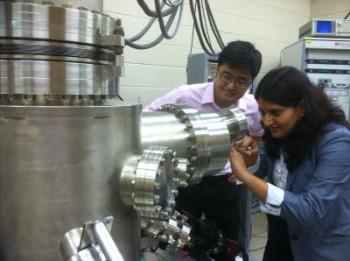May 18 2013
A team of researchers from several universities – including UCF –has observed a rare quantum physics effect that produces a repeating butterfly-shaped energy spectrum in a magnetic field, confirming the longstanding prediction of the quantum fractal energy structure called Hofstadter's butterfly.
 UCF team Masa Ishigami and Jyoti Katoch work to capture the illusive Hofstadter's butterfly effect. Credit: UCF
UCF team Masa Ishigami and Jyoti Katoch work to capture the illusive Hofstadter's butterfly effect. Credit: UCF
This discovery by the team paves the way for engineering new types of extraordinary nanoscale materials that can be used to develop smaller, lighter and faster electronics, including sensors, cell phones, tablets and laptops.
First predicted by American physicist Douglas Hofstadter in 1976, the butterfly pattern emerges when electrons are confined to a two-dimensional plane and subjected to both a periodic potential energy and a strong magnetic field. The Hofstadter butterfly is a fractal pattern—meaning that it contains shapes that repeat on smaller and smaller size scales. Fractals are common in systems such as fluid mechanics, but rare in the quantum mechanical world. The Hofstadter butterfly is one of the first quantum fractals theoretically discovered in physics but, until now, there has been no direct experimental proof of this spectrum.
Columbia University led the study and also involved scientists from the City University of New York, Tohoku University and the National Institute for Materials Science in Japan. Columbia prepared the sample and the UCF team measured the regular recurrence of the high-fidelity periodic pattern, engineered by inducing nanoscale ripples on graphene, a carbon material. The measured recurrence served as the essential proof that the measured spectrum was indeed the Hofstadter butterfly. The image that captured the evidence was taken in UCF Assistant Professor Masa Ishigami's laboratory.
The study is published in today's advance online publication of Nature http://www.nature.com/nature/journal/vaop/ncurrent/full/nature12186.html
Jyoti Katoch, Ishigami's graduate student, used a non-contact atomic force high-resolution microscope to image the ripples, which have the height of only 0.2 angstroms (twenty trillionth of a meter), to confirm that the observed Hofstadter butterfly spectrum indeed matched the theoretical prediction.
"The arrangement of individual atoms, even just one atom can drastically alter properties of nanoscale materials. That is the basis for nanotechnology," Ishigami said. "Atomic structures must be resolved to understand the properties of nanoscale materials. What we do here at UCF is to explain why nanoscale materials behave so different by resolving their atomic structures. Only when we understand the origin of the extraordinary properties of nanoscale materials, we can propel nanoscience and technology forward. What Jyoti has done here is to image how graphene is rippled to explain the observed Hofstadter spectrum."
UCF's laboratory utilizes a novel, the state-of-the-art microscopy technique to simultaneously determine the atomic structure and electronic properties of nanoscale materials such as graphene.
Katoch has been working with Ishigami since 2008, when Ishigami joined UCF. Katoch helped build the laboratory and developed the atomic-resolution capability critical to capturing the picture proof for this study.
Ishigami has a Ph.D. in physics from the University of California at Berkeley and a bachelor's degree in physics from the Massachusetts Institute of Technology. He has won multiple awards, including the Intelligence Community postdoctoral fellowship and the Hertz graduate fellowship, and has published more than 30 papers in journals including Science.